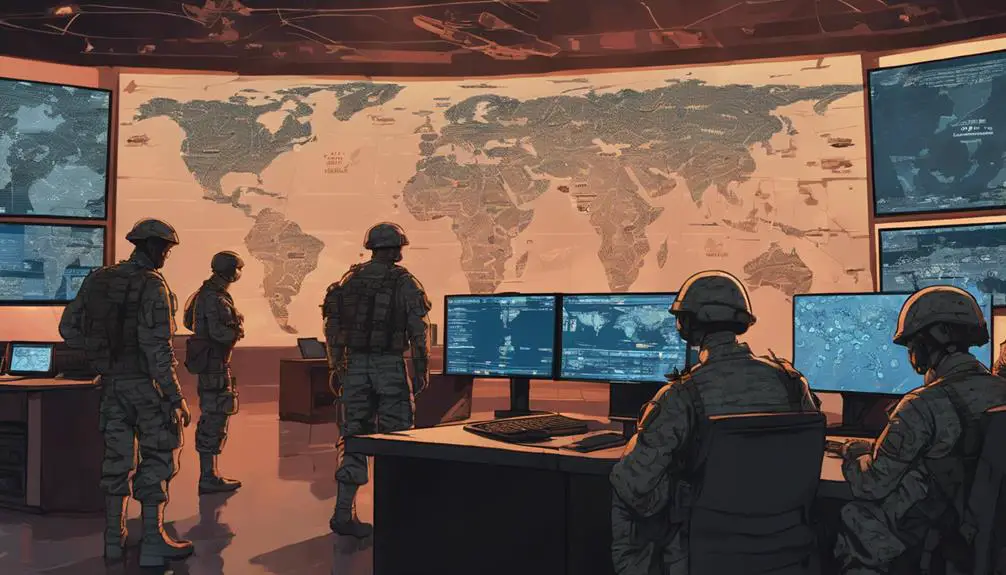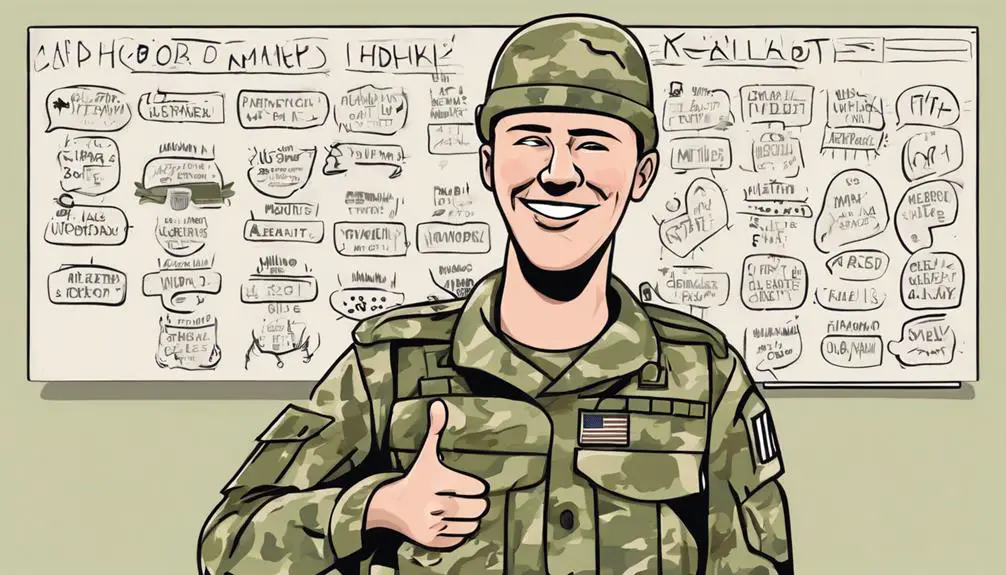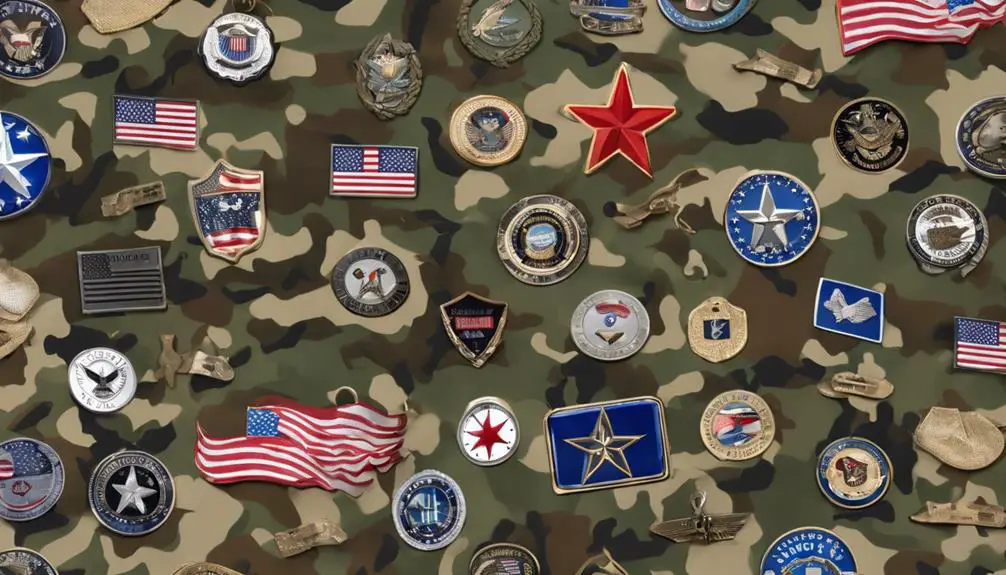You're about to begin on a journey into the world of slang military acronyms, where brevity and secrecy have shaped a unique language over the past century. From 'FOB' to 'CO' and 'SITREP', mastering common terms is essential for effective communication and teamwork. You'll encounter acronyms like 'AO', 'TOC', and 'SOF' that are critical for situational awareness during operations. Informal slang terms like 'grunt' and 'devil dog' reflect unique characteristics of military ranks and roles. As you venture deeper, you'll uncover the humor and sarcasm woven into military language, and discover how it has evolved into a distinct culture.
Origins of Military Slang Acronyms

As you explore the world of military communication, it becomes apparent that the origins of slang acronyms can be traced back to the early 20th century, when the need for expedient and secure communication became essential.
During World War I, the use of radio communication became widespread, and the need for brevity and secrecy in transmission became vital. This led to the development of code words and abbreviations, which eventually evolved into the slang acronyms we're familiar with today.
The historical roots of military slang acronyms can be attributed to the early code development efforts. In the 1920s, the US Army established the first cryptanalytic unit, which laid the groundwork for modern encryption techniques. This led to the creation of cryptic communication systems, which relied heavily on abbreviations and acronyms to convey complex information quickly and securely.
As you explore further into the world of military communication, you'll discover that the development of code words and abbreviations played a significant role in shaping modern military slang. The early 20th century marked the beginning of a new era in military communication, where speed, security, and brevity became the hallmarks of effective communication.
Common Terms for New Recruits
You'll quickly realize that familiarizing yourself with common military acronyms is essential to understanding the complex world of military communication. As a new recruit, you'll be bombarded with unfamiliar terms and abbreviations that can be overwhelming at first. To help you navigate this linguistic landscape, let's break down some essential 'Boot Camp Lingo' and 'Newbie Nicknames' you'll encounter.
In the military, new recruits are often referred to as 'Boot' or 'Newbie.' These terms are used to distinguish inexperienced personnel from seasoned veterans. You might also hear drill instructors or senior personnel referring to you as 'Maggot' or 'Rook,' which are colloquialisms for new recruits.
Familiarize yourself with essential acronyms like 'FOB' (Forward Operating Base), 'CO' (Commanding Officer), and 'SITREP' (Situation Report). These acronyms will become second nature as you progress through your military career.
Mastering these common terms will help you better understand military communication and integrate seamlessly into your unit. Remember, understanding military acronyms is key to effective communication and successful teamwork.
Acronyms for Military Operations

During military operations, understanding acronyms like 'AO' (Area of Operations), 'TOC' (Tactical Operations Center), and 'SOF' (Special Operations Forces) is essential to situational awareness and effective execution of missions. As a military personnel, you need to be familiar with these terms to stay ahead in the game.
Here's a snapshot of some common operation-related acronyms:
| Acronym | Meaning |
|---|---|
| OPLAN | Operation Plan |
| OPORD | Operation Order |
| OPSEC | Operations Security |
You'll often come across operation names with code word classification, such as 'Operation Desert Storm' or 'Operation Enduring Freedom'. These names are usually classified as Top Secret, Secret, or Confidential, depending on the level of sensitivity. Understanding these acronyms and operation names is vital for effective communication and execution of missions. As you navigate the complex world of military operations, being familiar with these terms will help you stay informed and ahead of the curve.
Slang for Military Ranks and Roles
Military personnel often use informal slang to refer to various ranks and roles, such as 'grunt' for an infantryman, 'devil dog' for a Marine, or 'squid' for a sailor. You'll also hear 'jarhead' for a Marine, 'bubblehead' for a submariner, or 'zoomie' for an Air Force pilot. These rank nicknames and role stereotypes are deeply ingrained in military culture, often reflecting the unique characteristics or traits associated with each role.
For instance, the term 'grunt' originated from the sound infantrymen made while carrying heavy packs, while 'devil dog' is a nod to the Marines' fierce reputation. Similarly, 'squid' likely refers to the sailor's uniform resembling a squid's tentacles. These colloquialisms serve as a shorthand way to identify oneself or others within the military community, often with a hint of humor and camaraderie.
As you navigate the military's linguistic landscape, you'll encounter many more such examples. Understanding these slang terms can help you better connect with military personnel and appreciate the nuances of their culture. By recognizing the context and history behind these rank nicknames and role stereotypes, you'll gain a deeper appreciation for the military's rich heritage and traditions.
Humor and Sarcasm in Acronyms

As you venture into the world of military acronyms, you'll soon discover that humor and sarcasm play a significant role in shaping the language and culture of the armed forces. It's not uncommon to find acronyms that incorporate dark humor or sarcasm, often serving as a coping mechanism for the stresses and dangers of military life.
For instance, the acronym 'FUBAR' (Fouled Up Beyond All Recognition) is a tongue-in-cheek acknowledgment of the chaos that can ensue in high-pressure situations. This type of humor serves as a way to diffuse tension and maintain morale.
Sarcasm also plays a notable role in military acronyms, often used to poke fun at the bureaucratic red tape and administrative tasks that come with military life. Acronyms like 'SNAFU' (Situation Normal: All Fouled Up) and 'BOHICA' (Bend Over, Here It Comes Again) exemplify this type of sarcasm.
These acronyms serve as a way to vent frustrations and maintain a sense of humor in the face of adversity. By incorporating humor and sarcasm into their language, military personnel have developed a unique culture that helps them cope with the demands of their profession.
Evolution of Military Lingo Culture
Your exposure to military lingo has likely led you to wonder how this unique culture of acronyms, slang, and jargon evolved over time. The evolution of military lingo culture is a fascinating story that spans centuries, influenced by technological advancements, social changes, and global events.
| Era | Key Events | Lingo Impact |
|---|---|---|
| World War I | Trench warfare, radio communication | Emergence of slang, abbreviations for military terms |
| World War II | Global conflict, code-breaking | Increased use of acronyms, cryptic language |
| Cold War | Technological advancements, espionage | Rise of jargon, specialized terminology |
| Gulf War | Satellite communication, digitalization | Lingo revival, influence of technology |
| Modern Era | Social media, global connectivity | Globalization of military lingo, online communities |
The influence of technology has played a significant role in shaping military lingo culture. From radio communication in World War I to satellite communication in the Gulf War, technology has enabled faster and more efficient communication, leading to the development of new slang, acronyms, and jargon. This lingo revival has been further fueled by social media and online communities, allowing military personnel to connect and share their unique language. As you explore the world of military acronyms, you'll discover how this culture continues to evolve, adapting to new technologies and global events.
Frequently Asked Questions
Are Military Slang Acronyms Used Only in the US Military?
You might assume that military slang acronyms are a uniquely American phenomenon, but that's not the case. While the US military has developed its own set of acronyms, other countries' militaries have their own versions too.
In fact, global adoption of military slang acronyms is widespread, with international variations reflecting each country's specific needs and cultural nuances.
Can Civilians Use Military Slang Acronyms in Everyday Conversation?
You might wonder if it's okay to casually drop military slang acronyms in everyday conversation. While it's not inherently wrong, consider the social acceptance and potential cultural appropriation implications.
Using terms without understanding their origins or context can come across as insensitive or pretentious. Be mindful of your audience and the weight of these acronyms; use them thoughtfully to avoid perpetuating cultural appropriation or disrespect.
Are Military Slang Acronyms Only Used for Communication Purposes?
You might think that military slang acronyms are only used for communication purposes, but that's not entirely true. While they do enhance message clarity, their function goes beyond that.
In reality, these acronyms also serve as a code, providing a layer of security by obscuring sensitive information from unauthorized personnel. Breaching this code could have serious consequences, so it's important to understand the full scope of their usage.
Do All Military Branches Use the Same Slang Acronyms?
You're wondering if all military branches use the same slang acronyms. The answer is no, they don't. Branch variations and service differences lead to distinct slang acronyms.
For instance, the Army's 'HOOAH' (Heard, Understood, Acknowledged) differs from the Navy's 'BRAC' (Base Realignment and Closure).
Each branch develops its unique vocabulary, reflecting their specific needs and cultures. While some acronyms might be shared, each service has its own language, shaped by its history, traditions, and operational requirements.
Are Military Slang Acronyms Officially Recognized by the Military?
You're about to uncover the truth behind military slang acronyms, and it's like lifting the veil off a secret society.
When it comes to official recognition, you'll find that military slang acronyms don't have a formal stamp of approval from the top brass. While they're widely used, they don't fit into an official classification system.
Military approval is reserved for standardized terminology, not colloquialisms. So, while they're ubiquitous, they operate in a gray area, without formal recognition or classification.
Conclusion
As you explore the world of military slang acronyms, you'll uncover a language that's both functional and fascinating.
Did you know that the US military uses over 15,000 acronyms, with new ones emerging every year? This staggering number highlights the dynamic nature of military lingo, constantly evolving to meet the needs of modern warfare.
As you navigate this complex lexicon, keep in mind that understanding these acronyms is crucial to revealing the culture and camaraderie that define military life.







